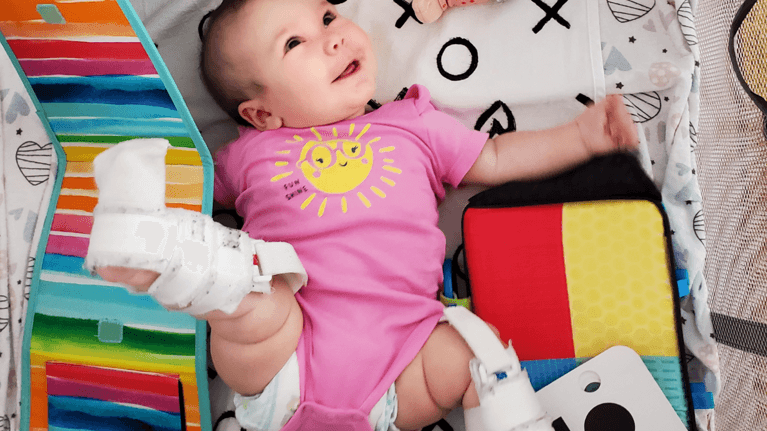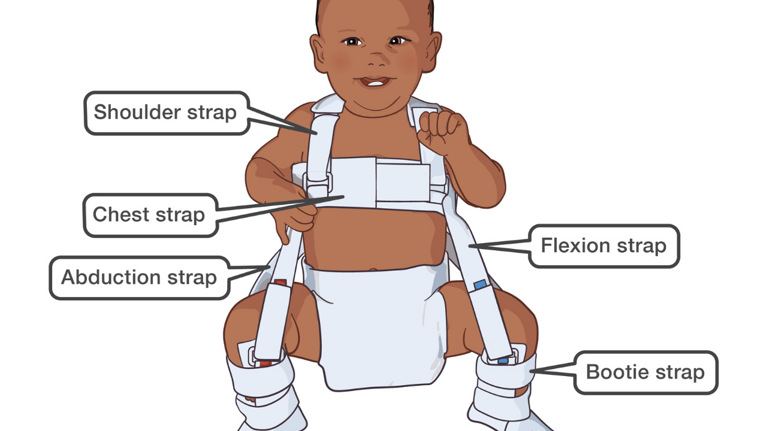What is Hip Dysplasia? One Family Shares Their Experience
By Laura Grande
Updated Jul 13, 2023
Although it appears incredibly restrictive, I was shocked by the range of motion Elodie had. She could still kick to her heart's content. Source: Laura Grande
As I lay in a hospital bed a few hours after my C-section, the resident pediatrician was standing nearby, moving my newborn daughter’s legs in slow circles. The process, I later learned, was called the Barlow Maneuver — a common practice to check hip stability in newborns.
“Her hip joints are making a slight clicking noise, especially on the left side,” the pediatrician said suddenly.
“So, what does that mean?” I vaguely recall asking.
“There’s a possibility of hip dysplasia, but we’ll need an ultrasound to know for sure,” was the response.
I didn’t know what any of that meant, and, in my groggy state of mind, I don’t remember asking any follow-up questions at the time. However, I recall frantically Googling the condition as soon as we were home from the hospital while my daughter, Elodie, slept on me.
A few weeks later, we had an appointment at the Baby Hip Clinic — the orthopedic division at SickKids in Toronto — for an ultrasound. Elodie was eventually discharged wearing a full Pavlik Harness, which, to her hyper-sensitive mama, resembled some sort of velcroed medieval device that held her in a perpetual frog position.
 Over time, the Pavlik Harness can get a little grimy - as you can see in the bootie strap area. Source: Laura Grande
Over time, the Pavlik Harness can get a little grimy - as you can see in the bootie strap area. Source: Laura GrandeWhat is hip dysplasia?
As it turns out, it’s a relatively common condition. The International Hip Dysplasia Institute states that one in 10 infants are born with some level of hip instability, while one in 100 babies are treated for actual hip dysplasia.
It’s essentially an umbrella term for any of the following: infantile hip instability, dislocation or shallowness of the hip socket. It’s when the femoral head (the highest part of the thigh bone) doesn’t fit correctly with the pelvis at birth. If left untreated, it can result in damaged cartilage, limping, joint pain, hip dislocation and, later in life, osteoarthritis.
What causes hip dysplasia?
According to the International Hip Dysplasia Institute, the exact causes are unknown. However, most medical professionals agree that it happens around birth when a baby’s hip sockets are at their shallowest so they can pass through the birth canal. After delivery, those loose ligaments typically recover without incident. However, that’s not always the case.
A few factors — outside of family history — can contribute to hip dysplasia in newborns. As it turned out, Elodie met three of the main markers:
Firstborn. Check. Female. Check. Breech birth. Check.
So, she came by it honestly.
I asked Catharine Bradley, a physiotherapist practitioner who co-supervises the Baby Hip Clinic at SickKids, why these three factors, in particular, tended to result in hip dysplasia.
“The thinking around the firstborn is that the uterus is pretty tight, so it’s a packaging thing, whereas, with moms who have had multiple [kids], their uterus is not quite as snug,” she explains. “[It] girls because they are more susceptible to their mom’s hormones at birth, and so their hips tend to be a bit more lax. And then the breech [birth] is positional, so they’re further down into the womb and bum-down, so their hips are being held in tight.”
How does the Pavlik Harness work?

It’s the most common brace to treat hip dysplasia in babies under six months of age. For the first few weeks, Elodie had to wear it 24/7. It has straps, like stirrups, fastened around the baby’s legs and held with additional shoulder and chest straps. Although it appears incredibly restrictive, I was shocked by the range of motion Elodie still had: she could kick and stretch with ease.
The harness allows the hip and thigh bones to connect and strengthen the ligaments as the baby grows. Which was all well and good… until my husband and I realized we had to give her sponge baths and change her diapers while maneuvering around all the straps. (Yes, the harness can get absolutely disgusting, riddled with spit-up and diaper-related stains.) Oh, it must also remain completely dry to prevent skin irritation.
The major downside, though? It had to be worn underneath the clothes, so we had to say goodbye to all those cute tiny onesies sitting in her dresser. We frantically searched online for hip dysplasia outfits, which were nearly impossible to find given the condition being so common. We eventually tracked down a handful of items from Marks & Spencer in London.
But the part I struggled with the most was breastfeeding. Suddenly, my girl felt so foreign in my arms. It took us days to figure out a new rhythm for feedings and snuggles. We both shed some tears in the process. But, as with many things that come with first-time motherhood, you learn on the fly and come to a place of comfort together.
The Royal Children’s Hospital Melbourne has a helpful fact sheet for tips and tricks on using and cleaning the Pavlik Harness that ended up putting us at ease more than once.
 An example of the special hip dysplasia clothing I managed to track down at Marks & Spencer in London, England. The pants and shirt both have button fastenings along the edges for easy dressing. Source: Laura Grande
An example of the special hip dysplasia clothing I managed to track down at Marks & Spencer in London, England. The pants and shirt both have button fastenings along the edges for easy dressing. Source: Laura GrandeHow serious is hip dysplasia?
It depends. We were lucky. Elodie wore the harness for 12 weeks, and for the last couple of weeks, we could take her out of the harness for one hour a day — for bathing and tummy time.
If caught early, it’s a treatable condition. In some cases of greater severity, such as a complete dislocation, it can result in different splints, casts (instead of a harness) or surgery.
“Ninety percent of the time, we will start [a] with the Pavlik Harness, assuming they are young enough,” Bradley explains. “If they don’t do well with [it], there’s another type of brace called the Hip Abduction Brace, so we’ll move to that. The options after that become surgical.”
And, although it seems implausible, the condition doesn’t hurt. “It’s not painful at all,” Bradley assures me. “Even with a dislocated hip, kids will still get up and learn to walk around.”
Can parents detect if their baby has hip dysplasia?
Although usually caught early by a medical professional, parents can notice signs of hip dysplasia at home — although, as Bradley notes, it can be tricky.
“[You] leg length differences, and clicking in the hips, or any sort of abnormal posturing or asymmetry when they’re kicking,” she says. “Typically, a kid with a dislocated hip will kick less, or it won’t be as forceful as the other side.”
As for Elodie, she wore the Pavlik Harness for close to three months. After the stress of that first week, the three of us adapted quite well. The harness never phased her, nor did she develop any uncomfortable rashes or chafing. She smiled, she cooed, she gurgled, she kicked. She was crawling by nine months and fully walking by 12.
Now, at almost 18 months, she’s an active toddler who loves to run and climb onto the couch. In the grand scheme of things, the Pavlik Harness was a brief period in her life. After washing that harness one last time, I folded it up and put it in her memento box.
Weekly Newsletter
Keep up with your baby's development, get the latest parenting content and receive special offers from our partners